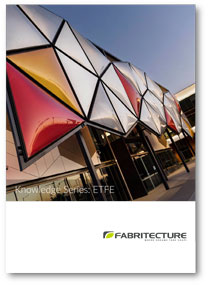ETFE (Ethylene tetrafluoroethylene) is a lightweight material that is an excellent alternative to glass. It is a popular choice for applications where high light and UV transmission are required, such as large-span roofing, skylights, and facades. It is often considered a value-engineered option over glass roofing and these six benefits below highlight why.
1. Safety
One of the benefits of ETFE is that it is extremely fire safe. This is because it does not promote the spread of flames and is considered a self-extinguishing material. If flames or hot gases meet the cladding, it will begin to soften, melt, and shrink away from the affected area, creating a hole in the material where gasses and smoke are able to be ventilated from the building.
2. Controlling UV Through Custom Printing
Another benefit of ETFE material is that it can be used to control UV radiation penetration. When used in a clear state, the transparent material allows for adequate visibility and can be printed, or laser etched with distinct designs. These designs, known as frit patterns, prevent light from entering while still allowing light to pass through certain parts of the canopy walls.
3. Maintenance Requirements
As it is not affected by UV light, atmospheric pollution, and other forms of environmental weathering, ETFE has an exceptional life expectancy. While no ETFE structures have been in place for long enough to gain a true understanding of the full life cycle, it is predicted that the material has a life expectancy greater than 50 years.
When considering the cleaning and maintenance requirements, the material does not require frequent cleaning as the smooth surface minimises the dirt retained and allows for dirt to be washed away by rainfall. A routine cleaning of the material is suggested to take place every 2-3 years and a routine maintenance check every 6 months, which is significantly less than alternative material solutions.
4. Cost
Weighing approximately 1% of the weight of glass, ETFE is designed to be very lightweight, making it easier to transport and install as well as requiring less structural framework due to the lightweight membrane. As well as being a cheaper alternative to glass, any tears or punctures in the material can be patched, rather than requiring the entire film to be replaced.
5. Lighting
Another major benefit of ETFE is its high translucency. Because it conducts heat and light extremely well, ETFE has an R-value of as much as three times that of glass. In real-world applications, this means that less material is used to achieve the same or even better insulation than with other materials.
6. Sound Absorption
Due to its extremely low mass, ETFE building material is acoustically transparent, which reduces the amount of reverberation within a room by absorbing the acoustics.
The exact sound levels within an enclosed space will depend on the cushions and the project (e.g., size/scale of room, incline of the pillows, materials used inside, and the span of the pillows).








